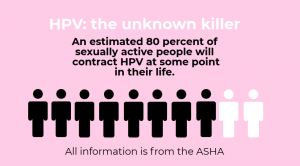What is human papillomavirus infection, or HPV? With more than 100 varieties of HPV existing, this infection commonly causes warts, known as a low risk factor and cervical cancers, known as a high risk factor. These cancers includes cancer of the vulva, vagina, penis, or anus for those infected. According to cdc.gov, HPV is the most common sexually transmitted infection, or STI.
79 million Americans, most in their late teens and early 20s, are infected with HPV. About 14 million people become infected each year, also according to cdc.gov.
It’s recommended that all boys and girls ages 11 or 12 years old should get vaccinated.
How can you protect yourself from contracting HPV? If you are sexually active, you can use latex condoms, and be in a mutually monogamous relationship to reduce your risks of contracting HPV. Protective measures also include cervical screening and vaccinations.
According to cdc.gov, the HPV vaccination can protect against diseases (including cancers) caused by HPV when given in the recommended age groups. It’s recommended that all boys and girls ages 11 or 12 years old should get vaccinated.

The HPV vaccination can protect against diseases (including cancers) caused by HPV when given in the recommended age groups. The CDC recommends that all boys and girls ages 11 or 12 years old should get vaccinated. Catch-up vaccines are recommended for boys and men through age 21 and for girls and women through age 26, if they did not get vaccinated when they were younger.
Students can contact their healthcare providers for more information regarding the HPV vaccination.
There is no test to find out a person’s “HPV status,” and there are no approved HPV tests to find HPV in the mouth or throat. Similar to other sexually transmitted infections and diseases, HPV does not have any recognizable symptoms.
Therefore, the easiest way to avoid contracting HPV is by using one or more prevention methods.








